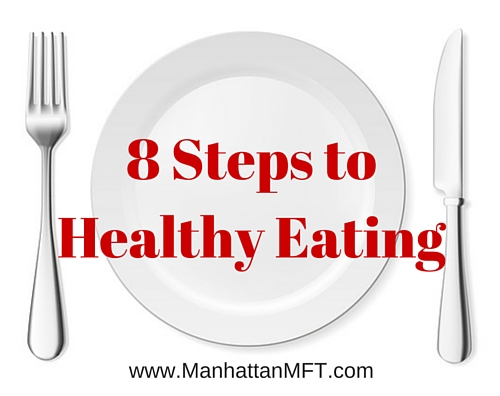Because you are an emotional eater, you eat when experiencing difficult emotions, not when you are physically hungry. You might even eat when you’re feeling happy. After these episodes with food you feel anxious, guilty, depressed or hopeless. The feeling that caused you to turn to food in the first place remains unaddressed.
Here are key steps to help you break this vicious cycle: 1. Find a therapist trained in eating disorders. Use therapy to explore underlying causes and to learn tools to manage your eating. Causes are complicated and varied. Some examples: alcohol abuse; inappropriate sexual behavior; divorce; bullying; family history of disordered eating. However, sometimes your childhood was happy and you felt loved and cherished. There was no trauma. Given the cultural value placed on thinness, the ubiquity of fat prejudice, body shaming attitudes and our dieting obsession, anyone can develop disordered eating. The goals of therapy are self-awareness and self-acceptance, not blame or judgment. 2. Learn to identify your feelings. Emotional eaters often don’t know what they’re feeling. When trying to figure this out, don’t stop at “I feel fat”. Dig beneath the surface. Technically, fat is not a feeling. Probe more. What’s underneath? Feelings are both obvious and nuanced. Your therapist can help you with this. 3. Learn to deal with your emotions directly. Face them. This takes practice and is a process. For example, in the above scenarios: Carefully examine and acknowledge what you are feeling during your argument with your mother. Take responsibility, practice with your spouse and then approach your mother again with confidence that you can express your feelings honestly and respectfully. Think about what topics you want to discuss with your supervisor. Practice with a co-worker. Remember, you have the right to express yourself directly, in a calm way, with any supervisor. After that bad date, bypass the kitchen, go straight to your bedroom and call – don’t text – your best friend. You’ll get more from her than you could ever get from Oreos. As you’re beginning to learn about yourself, address your food behaviors: 4. Choose a food plan that works for you. It might be best for you to focus first on maintaining your present weight while you learn to control your bingeing. As you begin to identify and cope with your emotions you will stop your weight gain and feel more in control. You can then carefully select a weight loss plan that is realistic and does not leave you feeling deprived. 5. Plan ahead. To the extent that it’s possible, decide the night before what you’ll eat the next day. It might help to share your plan with a trusted friend, a “food sponsor”, a nutritionist or your therapist. 6. Avoid your trigger foods. You will be able to eat your favorite treats after you’re comfortably managing your everyday choices and have a handle on your bingeing. 7. Learn hunger and fullness. This is essential. Your body will tell you when you are hungry. Don’t go by the clock or someone else’s schedule. This isn’t always practical, but do the best you can. Emotional eaters can’t distinguish between feeling full and feeling stuffed. I’ll talk more about how to identify fullness in the future. Assuming you’re in otherwise good health, if you start eating when you are hungry and stop when you are full, you will not gain weight, regardless of what food choices you are making. 8. Celebrate eating. Reclaim your right to enjoy food! Allow yourself to taste your food, using all five senses: seeing, smelling, touching, hearing and tasting. Light a candle, eat with a friend. Make it a happy experience. You deserve to enjoy eating! Finally, don’t trivialize your problem or yourself. You have a complicated, serious condition. You are not weak. Treat yourself with loving kindness. Next time you hear yourself say “I was good today” when you ate well, instead say “I made caring food choices” or “I took care of myself with food today”. It’s not about good or bad. It’s about self-care and self-love. Comments are closed.
|
Categories
All
Archives
March 2023
|
[email protected]


 RSS Feed
RSS Feed